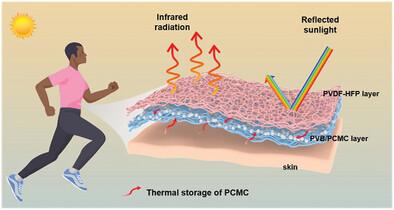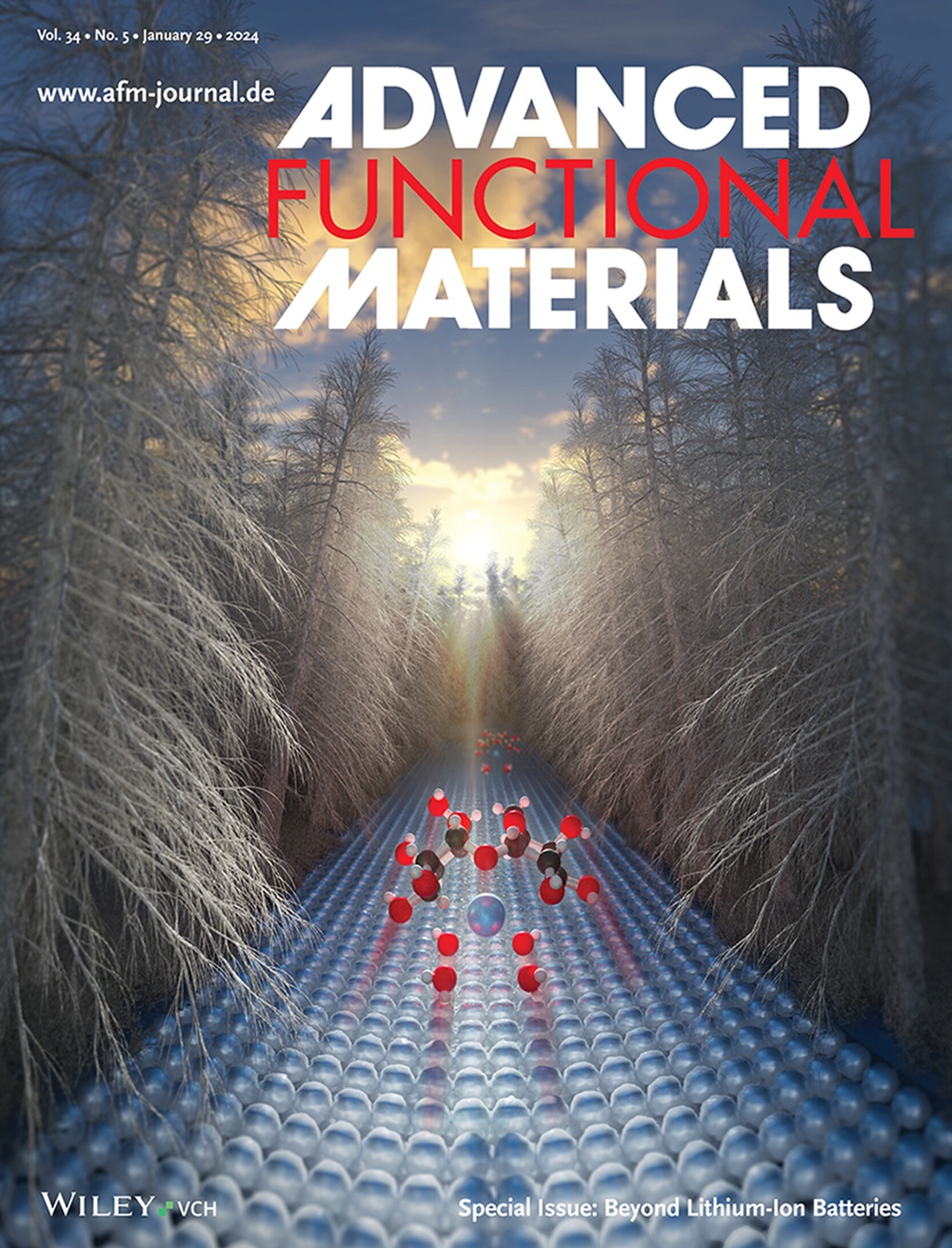通过电纺丝在纳米纤维纺织品中增加相变微胶囊的新方法
IF 18.5
1区 材料科学
Q1 CHEMISTRY, MULTIDISCIPLINARY
引用次数: 0
摘要
相变纺织品可以在多变的环境中实现温度调节,然而,由于相变材料(PCM)用量越大越容易发生泄漏,因此在纺织品中增加相变材料(PCM)的用量仍然是一项重大挑战。本文提出了一种利用电纺丝技术制造嵌入大量相变微胶囊(PCMC)的分层纳米纤维纺织品的新方法。这种纳米纤维织物由聚偏氟乙烯-六氟丙烯纤维(PVDF-HFP)层和掺杂 60 wt% PCMC 的聚乙烯醇缩丁醛纤维(PVB/PCMC-60)层组成。令人欣慰的是,掺杂的 PCMC 没有出现断裂迹象,并表现出卓越的循环稳定性。此外,掺入 PCMC 不会影响 PVDF-HFP 层的光谱特性,同时还能为 PVB/PCMC-60 层提供大量的熔融焓(92.6 J g-1)。这就弥补了辐射冷却能力的不足,有效缓解了织物的温度波动和过热现象。室外测试结果表明,与不含 PCMC 的织物(即 PVDF-HFP/PVB)和棉织物相比,纳米纤维织物的温降分别为 3.7 和 14.8 °C,亚环境温降为 6.5 °C。此外,纳米纤维纺织品还具有理想的机械强度、柔韧性、耐洗性、透气性、透湿性和防晒性。本文章由计算机程序翻译,如有差异,请以英文原文为准。

A Novel Method for Increasing Phase-Change Microcapsules in Nanofiber Textile through Electrospinning
Phase-change textiles can achieve temperature regulation in variable ambient environments, however, augmenting the amounts of phase-change materials (PCMs) in textiles remains a significant challenge due to the occurrence of leakage with higher amounts. Herein, a novel approach is proposed for the fabrication of a hierarchical nanofiber textile embedded with a substantial quantity of phase-change microcapsules (PCMC) using electrospinning. Such nanofiber textile is composed of a polyvinylidene fluoride-hexafluoropropylene fibers (PVDF-HFP) layer and a polyvinyl butyral fibers doped with 60 wt% of PCMC (PVB/PCMC-60) layer. Gratifyingly, doped PCMC shows no signs of rupture and exhibits excellent cycling stability. Furthermore, the incorporation of the PCMC does not affect the spectral characteristics of the PVDF-HFP layer while providing a substantial enthalpy of fusion (92.6 J g−1) to the PVB/PCMC-60 layer. This serves to compensate for the deficiency in radiative cooling capacity and effectively mitigates temperature fluctuations and overheating of the textile. Outdoor test results indicate that the nanofiber textile can achieve temperature drops of 3.7 and 14.8 °C compared to textile without the PCMC (namely PVDF-HFP/PVB) and cotton, and attains a subambient temperature drop of 6.5 °C. Additionally, the nanofiber textile exhibits desirable mechanical strength, flexibility, washability, breathability, moisture permeability, and sun protection.
求助全文
通过发布文献求助,成功后即可免费获取论文全文。
去求助
来源期刊

Advanced Functional Materials
工程技术-材料科学:综合
CiteScore
29.50
自引率
4.20%
发文量
2086
审稿时长
2.1 months
期刊介绍:
Firmly established as a top-tier materials science journal, Advanced Functional Materials reports breakthrough research in all aspects of materials science, including nanotechnology, chemistry, physics, and biology every week.
Advanced Functional Materials is known for its rapid and fair peer review, quality content, and high impact, making it the first choice of the international materials science community.
 求助内容:
求助内容: 应助结果提醒方式:
应助结果提醒方式:


